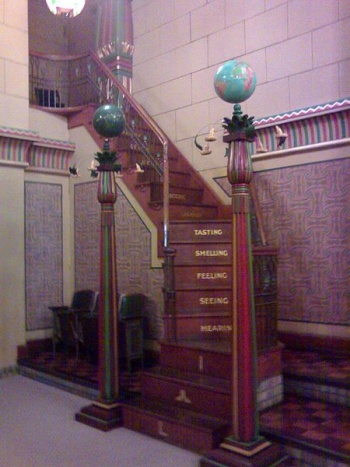En: Salt Lake Masonic Temple
Inhaltsverzeichnis
Salt Lake Masonic Temple
Source: Wikipedia
The Salt Lake Masonic Temple is the Masonic headquarters for Utah, and is Salt Lake City's best example of Egyptian Revival Architecture. It was completed in 1927, and is located in the South Temple Historic District of Salt Lake City, Utah.
General information
The Salt Lake Masonic Temple consists of several Lodge rooms, greater and lesser Halls, numerous lounges, a banquet hall, an auditorium, a library and administrative offices. The Temple is currently home to the Most Worshipful Grand Lodge of Free and Accepted Masons of Utah; six Salt Lake City Masonic Lodges (Wasatch Lodge No. 1, Mt. Moriah Lodge No. 2, Argenta Lodge No. 3, Acacia Lodge No. 17, Progress Lodge No. 22, and Kaibab Lodge No. 25); The Orient of Utah of the Ancient and Accepted Scottish Rite of Freemasonry; the Grand York Rite Bodies of Utah, and constituent Salt Lake York Rite Bodies; El Kalah Shrine; as well as the Grand Bodies for the ladies and youth organizations.
The building remains in continual use since it opened in 1927 and is maintained and operated by the Salt Lake Masonic Temple Association.
History
The decision to build the Salt Lake Masonic Temple took shape in the fall of 1920 as the Masonic population in Salt Lake City had out grown the existing Temple then located at the intersection of 2nd East and 1st South. The architect and Building Committee traveled to other cities reviewing existing Masonic Temples for favorable and unfavorable elements. Ultimately the committee resolved that the Salt Lake Masonic Temple be unique and not copied from existing Temples. By 1925 the plans had been completed, the land was purchased, and the interior furnishings arranged.
Much of the discussion preserved from the planning meetings centers on the amount of Masonic symbolism built into the Temple, and how it should be concealed, if at all.
Features
The Salt Lake Masonic Temple has been considered Salt Lake’s best example of Egyptian Revival architecture. The Egyptian motif was chosen for several reasons: 1. the Egyptian style was the height of fashion at the time; 2. existing Temples largely followed elements of the classical orders of architecture, so the Egyptian motif would ensure a unique Masonic experience; and 3. it provided ample opportunity to incorporate Masonic symbols without disclosing their presences or disrupting the visual harmony of the edifice.
The exterior of the Temple is composed of "Temple Brick", a brick face specifically designed for the Salt Lake Masonic Temple, that subsequently became a popular decorative architectural element.
Light is perhaps the most significant symbol of Freemasonry, and the architect incorporated many Egypyian references to Light into the design of the Temple. Allusions to the Egyptian god Horus (then considered by Egyptologists to be a god of Light) occupy much of the building, including the cornice at the main entrance. There are three entrances to the Temple, alluding to the three Lights of a Masonic Lodge. The main entrance from the north of the building; as north is deemed a place of darkness in Masonic ritual, hence those coming through the front door are traveling toward light.
The funerary ramp located west of the main entrance is surmounted by a scarab, the Egyptian symbol of resurrection and immortality, and together with the seven acacia flanking the ramp allude to Masonic belief in a Supreme Being and the immortality of the soul.
The main entrance is approached by a staircase of three flights respectively consisting of three, five, seven and nine steps. The staircase is flanked by two sphinxes. Each sphinx holds a single sphere, one celestial, one terrestrial, and each is arranged to contemplate its sphere.
Links
- Salt Lake Masonic Temple http://slcmta.org/
- Wasatch Lodge #1 http://www.wasatchlodge.org/publish/salt-lake-masonic-temple/
- Wikipedia https://en.wikipedia.org/wiki/Salt_Lake_Masonic_Temple

